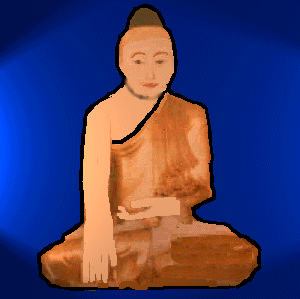



Image by permission.
Basic Description: Those who do not believe that Balarama is the 9th avatar of Vishnu place the original Buddha in this position.
Alternate Names : Siddhartha, Gautama, Sakyamuni, Tatagatha
History/Practices: Buddhism is, of course, its own religion. In the context of Hinduism, in an effort to minimize the effect of the Buddhist teachings, the Hindus incorporated Buddha into the Avatars of Vishnu.
Iconography: The iconography of the Buddha varies greatly from country to country and region to region. Buddhism is found in many different countries including: India, Sri Lanka, Tibet, Bhutan, Myanmar, Thailand, Malaysia, Indonesia, Cambodia, Laos, Vietnam, China, and Japan. In each of these places there are different ways of portraying the Buddha. Furthermore, the Buddha has many distinctive hand gestures (mudras), which may show him teaching, blessing, etc. The position in which his left hand lies open in his lap and the right hand points down to the ground indicates that he is a Buddha. No other spiritual being can hold his hands in this way. Specifically, the right hand calls on the earth to witness to his enlightenment.
Mythology: Siddhartha was born into a wealthy family, and was prophesied to be either a great king or a great religious figure. His father desired the former, and thereby kept Siddhartha from seeing the outside world. However, this was all changed when Siddhartha saw sickness, death, old age, and religious asceticism on a chariot ride. He spent several years as an ascetic, trying to find enlightenment that would lead him beyond the suffering of the world. When he remained unsuccessful in this attempt, he sat underneath a tree to meditate and then he suddenly saw the truth. While he was here he preached a simple message on the middle way between living in luxury or self-denial. Specifically, he introduced the Four Noble Truths of Budhism—denouncing desire as a means to eliminating suffering.